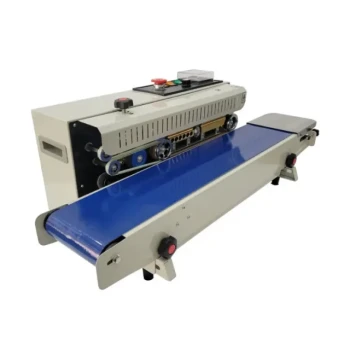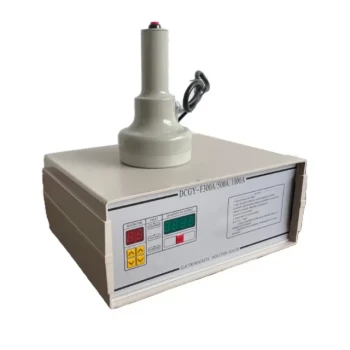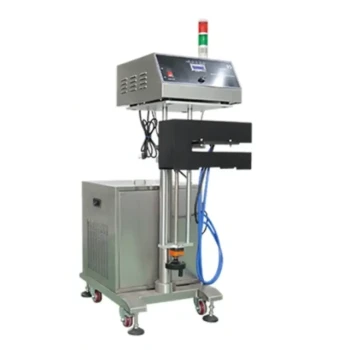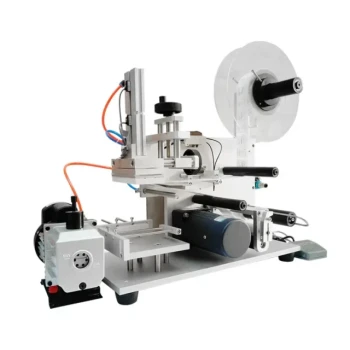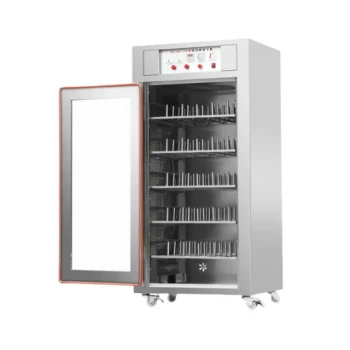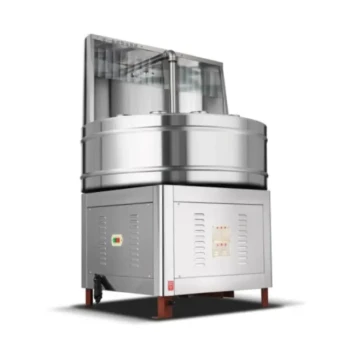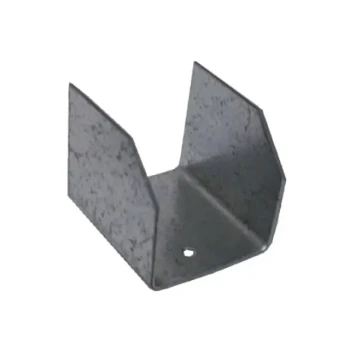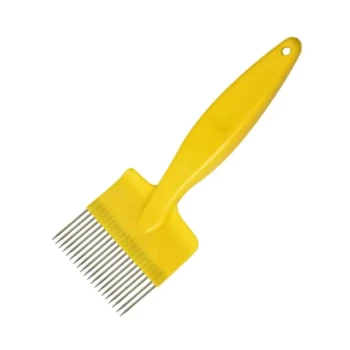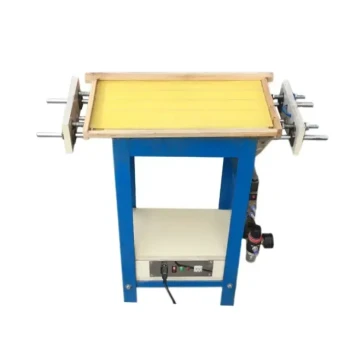At its core, a sealing machine works by applying focused energy—most commonly heat—to fuse a sealing material to a container's opening. This process melts a specific layer of the seal, which then bonds with the rim of the container as it cools, creating a permanent, airtight closure.
The true function of a sealing machine is not merely to close a package, but to create a precisely engineered barrier. This hermetic seal is critical for protecting the product from contamination, preserving its freshness, and providing clear evidence of tampering.
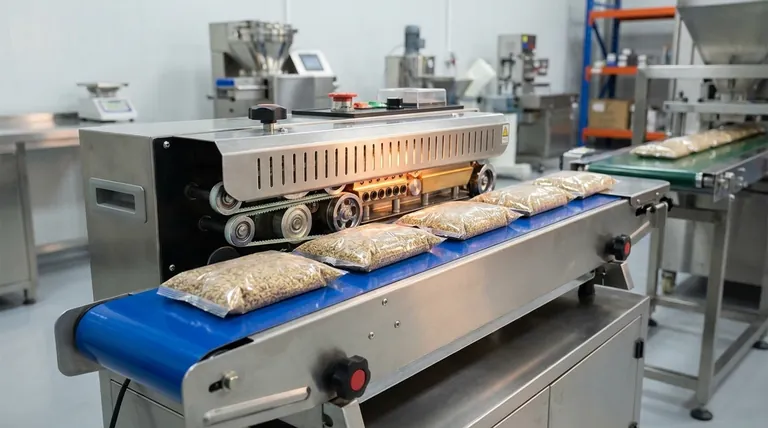
The Core Principle: Fusing Materials with Energy
The fundamental goal of any sealing process is to create a single, unified barrier where two separate materials—the container and the seal—once existed. This is achieved by creating a molecular bond between them.
The Role of Direct Heat and Pressure
The most straightforward sealing methods apply direct heat and pressure. A heated bar presses the sealing material against the container, melting the surfaces just enough for them to fuse together upon cooling. This is common for sealing flexible packaging like bags and pouches.
The Mechanism of Induction Sealing
For rigid containers like bottles and jars, induction sealing is the industry standard due to its speed and reliability. This non-contact method uses electromagnetism to generate heat exactly where it's needed.
The process unfolds in a few milliseconds as the container passes under a sealing head:
- An electromagnetic field is generated by the sealing head.
- This field creates an electrical current in the conductive aluminum foil layer of the cap liner.
- The resistance in the foil causes it to heat up instantly and intensely.
- This heat melts the polymer layer on the underside of the foil.
- The melted polymer fuses with the lip of the container, creating a strong, hermetic seal.
Why a Hermetic Seal is Non-Negotiable
Understanding the mechanism is only half the story. The "why" behind this technology reveals its importance in modern manufacturing and consumer safety.
Ensuring Product Freshness
The primary benefit of a hermetic seal is its ability to create a complete barrier against the outside environment. It blocks the exchange of oxygen, moisture, and other gases, which are the main drivers of spoilage, staleness, and degradation in food, pharmaceuticals, and chemicals.
Guaranteeing Safety and Contamination Prevention
An unbroken seal ensures that the product inside is sterile and free from airborne microbes, pollutants, and other contaminants. This is not a "nice-to-have"; it is a mandatory requirement for public health and safety, especially in the food and medical industries.
Providing Tamper Evidence
A foil seal provides an unambiguous, visual indicator that the product has not been opened or tampered with since it left the factory. If the seal is broken, punctured, or missing, the consumer is immediately alerted not to use the product, preventing potential harm.
Understanding Key Sealing Variables
A perfect seal is not automatic. It depends on the precise calibration of several factors, and failure to control them can lead to faulty seals that compromise the product.
Material Compatibility
The polymer on the seal must be chemically compatible with the material of the container (e.g., a PET bottle requires a seal designed for PET). Mismatched materials will not fuse properly, resulting in a weak or non-existent seal.
Calibrating Energy and Time
The amount of energy (heat) and the time it is applied are critical. Too little energy results in an incomplete weld, while too much can damage the seal, the product, or the container itself, creating a faulty closure.
Consistent Pressure and Alignment
For the polymer to fuse evenly, the seal must be pressed onto the container's rim with consistent pressure. Any misalignment or debris on the container lip can create gaps or channels in the seal, rendering it ineffective.
Making the Right Choice for Your Goal
The way you approach sealing should be dictated by your primary objective for the product.
- If your primary focus is extending shelf life: Ensure you use a high-quality hermetic seal and choose liner materials specifically designed to block oxygen and moisture transmission.
- If your primary focus is consumer safety: Prioritize a robust sealing process that creates a strong, tamper-evident bond that cannot be removed and reapplied.
- If your primary focus is operational efficiency: Calibrate your induction sealer to match your production line speed, ensuring a perfect seal on every unit without slowing down output.
By understanding the physics of how a seal is formed, you can better control the process to guarantee the integrity and safety of your product.
Summary Table:
| Sealing Method | Core Mechanism | Ideal For |
|---|---|---|
| Direct Heat & Pressure | A heated bar melts and fuses materials together. | Bags, pouches, and flexible packaging. |
| Induction Sealing | An electromagnetic field heats a foil liner to create a bond. | Bottles, jars, and other rigid containers. |
Ensure every product leaves your facility with a perfect, reliable seal.
At HONESTBEE, we understand that the integrity of your seal is the integrity of your product. For commercial apiaries and beekeeping equipment distributors, this means guaranteeing the purity and shelf life of honey, beeswax, and other hive products. Our wholesale-focused operations provide the durable, high-performance sealing equipment you need to protect your brand and meet industry safety standards.
Contact our experts today to find the right sealing solution for your production line.
Visual Guide
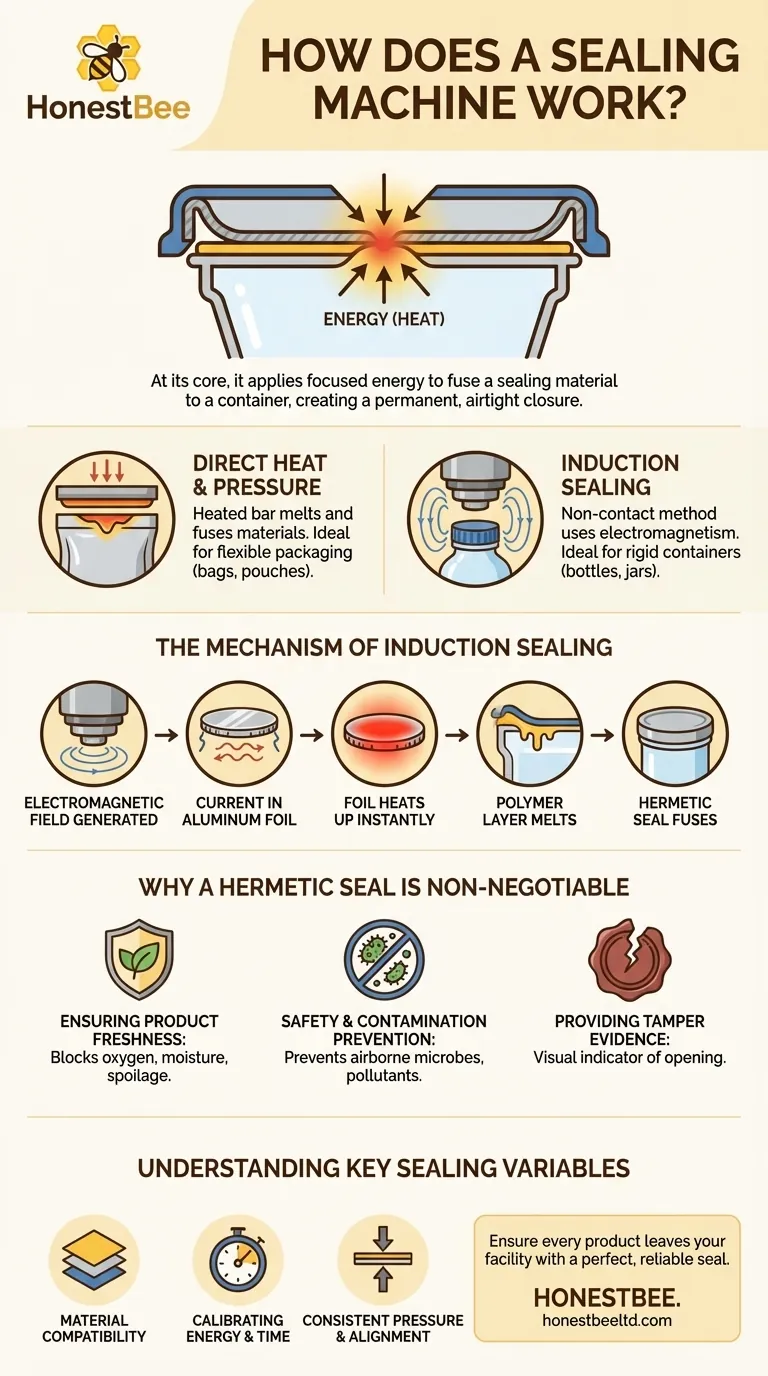
Related Products
- Automatic Continuous Heat Sealing Machine
- Handheld Induction Sealing Machine for Tamper Evident Packaging
- Professional Water Cooled Induction Sealing Machine for Bottles and Containers
- HONESTBEE Pneumatic Flat Surface Labeling Machine
- HONESTBEE Professional Cabinet Bottle Dryer
People Also Ask
- How does a sachet machine work? Unpacking High-Speed Form-Fill-Seal Efficiency
- How do I choose a sealing machine? Find the Perfect Sealer for Your Packaging Line
- What kind of machine is used to seal? Find the Right Sealing Technology for Your Needs
- What is the function of sealing machines? Ensure Product Integrity and Extend Shelf Life
- How do I choose a heat sealer? A Guide to Matching the Right Machine to Your Needs
